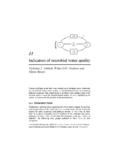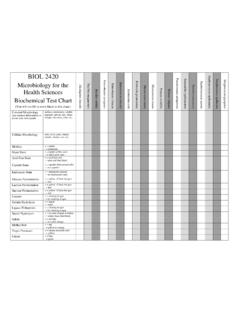Transcription of Food Testing- Bacillus species - IBMA
1 food testing - Bacillus species . Dr Roy Betts Head of Microbiology Campden BRI, Chipping Campden. UK. Who are Campden BRI? Independent food Research Organisation Membership based with over 2400 members International Client Base- 75 countries 350 staff 3500m2 laboratories, 3000m2 processing areas Microbiology 45 Staff ISO 9001 certified, ISO 17025 for many tests Our Locations Hungary Chipping Campden Nutfield Bacillus -----Why Test foods? Bacillus spp. Spore formers- can survive cooking Some are food spoilage organisms Some are human pathogens food Spoilage Rope in bread- Spoilage of heat processed foods Spore survival & growth Geobacillus stearothermophilus food Pathogens Emetic toxin (cereulide)- forms in food , heat resistant, vomiting Diarrhoeal-forms during vegetative growth in the gut.
2 Other Bacillus spp. Public Health England 2009 note: subtilis, licheniformis, pumilis, amyloliquifaciens as an issue (despite EFSA 2013 Qualified Presumption of Safety). Some UK companies are looking for total Bacillus numbers not due to this. Bacillus cereus Group B. cereus, B. mycoides, B. pseudomycoides, B. thuringiensis, B. weihenstephanensis, B. toyonensis, and B. anthracis Difficulty to differentiate using current standard test methods : non-haemolytic and non-motile Very generally in foods, presumptive : >105 seen as an health issue < 103 seen as acceptable Reactions of Various Bacillus spp. species Lecithinase Motility Penicillin susceptibility Crystal formation Bacillus anthracis -/w - S - Bacillus cereus + + R - Bacillus megaterium - + R - Bacillus mycoides + - R - Bacillus thuringiensis + + R +.
3 Bacillus circulans - + R - Bacillus coagulans - + R - Bacillus licheniformis - + R - Bacillus pumilus - + R - Bacillus subtilis - + R - Bacillus sphaericus - + R - group differentiation US FDA. Feature B. cereus B. thuringiensis B. mycoides B. weihenstepha B. anthracis nensis Gram reaction +(a) + + + +. Catalase + + + + +. Motility +/ (b) +/ (c) + . Reduction of + + + + +. nitrate Tyrosine + + +/ + (d). decomposed Lysozyme- + + + + +. resistant Egg yolk + + + + +. reaction Anaerobic + + + + +. utilization of glucose VP reaction + + + + +. Acid produced . from mannitol Hemolysis + + + + (d). (Sheep RBC). Known produces endotoxin rhizoidal growth growth at 6 C; pathogenic to pathogenicitye enterotoxins crystals no growth at animals and /characteristic pathogenic to 43 C humans insects EN/ISO 7932-2004.
4 Horizontal method for the enumeration of presumptive Bacillus cereus Colony count technique at 30 C. US FDA BAM test is the basically the same Note: Presumptive test the confirmatory stage does not enable the distinction of B. cereus from other closely related but less commonly encountered Bacillus species , such as B. anthracis, B. thuringiensis, B. weihenstephanensis, B. mycoides . Test Result MYP agar ( ) Formation of pink colonies surrounded by precipitate - Haemolysis- sheep blood agar Result: Count of presumptive Previous Versions of ISO 7932-1993 amended1997. Count of Same agar- same presumptive count Then confirmation by mannitol/egg yolk/polymyxin (MYP) agar medium, glucose fermentation, Voges-Proskauer reaction and nitrate reduction Result given as a count of on MYP Agar under the microscope A revised ISO 7932?
5 ISO/TC34/SC9 WG20. Considering use of the parasporal crystal Differentiation of cereus and thuringiensis MALDI ToF MS Identification Bruker Maldi biotyper * Bacillus anthracis, cereus, mycoides, pseudomycoides, thuringiensis and weihenstephanensis are closely related and members of the Bacillus cereus group. Discrimination between these species is difficult at this level of investigation and caution should be used in the assignment of a sample to a single species . Future Differentiation of Strains Previously Phenotypic/ecological methods Bacillus cereus sensu lato B. cereus B. thuringiensis, B. anthracis, B. mycoides, B. pseudomycoides, and B. weihenstephanensis Molecular Methods species boundaries difficult to define 16S rDNA sequencing MLST. PFGE (can separate anthracis from cereus/thuringiensis).
6 DNA Sequencing Solutions DNA sequencing could offer an ultimate way of identifying isolates It can identify strain to strain variations. Many ways to do it An Example: emetic strain 75% group sequence mapped against diarrhoeal strain 42% sequence mapped against 9% mapped against isolated as presumptive from a vegetable crop 75% group sequence mapped against 1% mapped against Final Thoughts group is difficult to differentiate using current standard methods (B. cereus, B. mycoides, B. pseudomycoides, B. thuringiensis, B. weihenstephanensis, B. toyonensis, and B. anthracis). The ISO 7932-2004 method is for presumptive , it can only identify anthracis out of the other species . In the future 7932 may have a method for presence of crystal included. DNA based methods could provide an answer Issue is getting good reference strains in a curated database, against which to compare Developed methods must be robustly validated ( ISO 16140.)
7 Based approaches). Sequencing offers a potential way of splitting the group Depends on a good database Could identify exact strains






